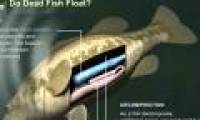
Scientists at the Nijmegen University in the Netherlands have discovered a bacterium that can produce oxygen to breathe.

In addition to sulfate, iron and manganese compounds can play an important role in converting methane to carbon dioxide and ultimately carbonate in Earth's oceans, according to a

Each bacterium knows itself so small that it is impossible to act on its own. So bacteria often wait, divide, and then engage in activities that require collective association.

We know that frogs are amphibians that can breathe through their lungs and skin. But when they were tadpoles they lived completely under water.

Other animals that die in the water often sink, particularly the fish quickly float to the surface. A special chemical mechanism made them so.

Our atmosphere is suffering

A new harm from the phenomenon of climate change has been discovered. And this time it is related to the mass death of fish.

US researchers found that the area known as the

Chromatiaceae is the name of the group of bacteria mentioned above, according to Livescience. They have the ability to synthesize energy by photosynthesis. Called anaerobic

Scientists have created a tree with towering branches like a large mushroom. These artificial plants can convert carbon dioxide emissions into oxygen.
 Scientists at the Nijmegen University in the Netherlands have discovered a bacterium that can produce oxygen to breathe.
Scientists at the Nijmegen University in the Netherlands have discovered a bacterium that can produce oxygen to breathe. In addition to sulfate, iron and manganese compounds can play an important role in converting methane to carbon dioxide and ultimately carbonate in Earth's oceans, according to a
In addition to sulfate, iron and manganese compounds can play an important role in converting methane to carbon dioxide and ultimately carbonate in Earth's oceans, according to a Each bacterium knows itself so small that it is impossible to act on its own. So bacteria often wait, divide, and then engage in activities that require collective association.
Each bacterium knows itself so small that it is impossible to act on its own. So bacteria often wait, divide, and then engage in activities that require collective association. We know that frogs are amphibians that can breathe through their lungs and skin. But when they were tadpoles they lived completely under water.
We know that frogs are amphibians that can breathe through their lungs and skin. But when they were tadpoles they lived completely under water. Other animals that die in the water often sink, particularly the fish quickly float to the surface. A special chemical mechanism made them so.
Other animals that die in the water often sink, particularly the fish quickly float to the surface. A special chemical mechanism made them so. Our atmosphere is suffering
Our atmosphere is suffering A new harm from the phenomenon of climate change has been discovered. And this time it is related to the mass death of fish.
A new harm from the phenomenon of climate change has been discovered. And this time it is related to the mass death of fish. US researchers found that the area known as the
US researchers found that the area known as the Chromatiaceae is the name of the group of bacteria mentioned above, according to Livescience. They have the ability to synthesize energy by photosynthesis. Called anaerobic
Chromatiaceae is the name of the group of bacteria mentioned above, according to Livescience. They have the ability to synthesize energy by photosynthesis. Called anaerobic Scientists have created a tree with towering branches like a large mushroom. These artificial plants can convert carbon dioxide emissions into oxygen.
Scientists have created a tree with towering branches like a large mushroom. These artificial plants can convert carbon dioxide emissions into oxygen.





 Do signals from extraterrestrial civilizations detected by Sky Eye really exist?
Do signals from extraterrestrial civilizations detected by Sky Eye really exist? 'City without air conditioning' in China: People don't know what heat is!
'City without air conditioning' in China: People don't know what heat is! The element of the sun god is giving scientists a headache
The element of the sun god is giving scientists a headache Unique Village: Roofs Become Roads for Residents!
Unique Village: Roofs Become Roads for Residents! Top 7 strange psychological effects of the brain that we all have without knowing
Top 7 strange psychological effects of the brain that we all have without knowing Which is the most terrifying bedroom elixir in Chinese history?
Which is the most terrifying bedroom elixir in Chinese history? Earth's core may start rotating in reverse
Earth's core may start rotating in reverse A day in Japan can be up to 30 hours long, does this country live in a different 'timeline'?
A day in Japan can be up to 30 hours long, does this country live in a different 'timeline'?